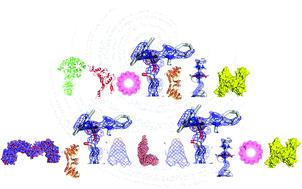当前位置:
X-MOL 学术
›
Chem. Commun.
›
论文详情
Our official English website, www.x-mol.net, welcomes your
feedback! (Note: you will need to create a separate account there.)
Recent advances in protein metalation: structural studies
Chemical Communications ( IF 4.3 ) Pub Date : 2021-1-5 , DOI: 10.1039/d0cc08053e Antonello Merlino 1, 2, 3, 4, 5
Chemical Communications ( IF 4.3 ) Pub Date : 2021-1-5 , DOI: 10.1039/d0cc08053e Antonello Merlino 1, 2, 3, 4, 5
Affiliation

|
Protein metalation is a process that determines the formation of adducts upon reaction of metal compounds with proteins. Protein metalation plays a crucial role in different fields, determining the mechanism of action and toxicity of metal-based drugs and the basis for the rational design of artificial metalloenzymes and protein-based metallodrug-delivery systems. Recent advances in structural studies unveiling the basis of the metal compounds/protein recognition process are briefly discussed here. The analysis of the structures of Pt, Au, Ru, Re, Pd, Ir, Os, Rh and Pt–As/protein adducts reveals that metal compounds (i) can bind proteins via non-covalent interactions or via coordination to selected residue side chains upon the release of labile ligands; (ii) can undergo reduction/oxidation processes upon protein binding that in turn can lead to changes in the metal coordination sphere and breakdown of the metal compound; (iii) can bind different protein recognition sites with a preference for selected side chains that is governed by hard and soft acids and bases, and with the number and type of binding sites changing over time; and (iv) can retain a certain degree of flexibility and reactivity in the final metal/protein adduct.
中文翻译:

蛋白质金属化的最新进展:结构研究
蛋白质金属化是确定金属化合物与蛋白质反应后加合物形成的过程。蛋白质金属化在不同领域起着至关重要的作用,它决定了金属基药物的作用机理和毒性,并为合理设计人工金属酶和蛋白质基金属药物递送系统奠定了基础。本文简要讨论了揭示金属化合物/蛋白质识别过程基础的结构研究的最新进展。对Pt,Au,Ru,Re,Pd,Ir,Os,Rh和Pt-As /蛋白质加合物的结构分析表明,金属化合物(i)可以通过非共价相互作用或通过在不稳定的配体释放后与选定的残基侧链配位;(ii)蛋白质结合后可能会经历还原/氧化过程,进而导致金属配位领域发生变化并破坏金属化合物;(iii)可以结合不同的蛋白质识别位点,优先选择由硬酸和软酸和碱控制的所选侧链,并且结合位点的数量和类型会随着时间而变化;(iv)可以在最终的金属/蛋白质加合物中保留一定程度的柔韧性和反应性。
更新日期:2021-01-19
中文翻译:

蛋白质金属化的最新进展:结构研究
蛋白质金属化是确定金属化合物与蛋白质反应后加合物形成的过程。蛋白质金属化在不同领域起着至关重要的作用,它决定了金属基药物的作用机理和毒性,并为合理设计人工金属酶和蛋白质基金属药物递送系统奠定了基础。本文简要讨论了揭示金属化合物/蛋白质识别过程基础的结构研究的最新进展。对Pt,Au,Ru,Re,Pd,Ir,Os,Rh和Pt-As /蛋白质加合物的结构分析表明,金属化合物(i)可以通过非共价相互作用或通过在不稳定的配体释放后与选定的残基侧链配位;(ii)蛋白质结合后可能会经历还原/氧化过程,进而导致金属配位领域发生变化并破坏金属化合物;(iii)可以结合不同的蛋白质识别位点,优先选择由硬酸和软酸和碱控制的所选侧链,并且结合位点的数量和类型会随着时间而变化;(iv)可以在最终的金属/蛋白质加合物中保留一定程度的柔韧性和反应性。











































 京公网安备 11010802027423号
京公网安备 11010802027423号